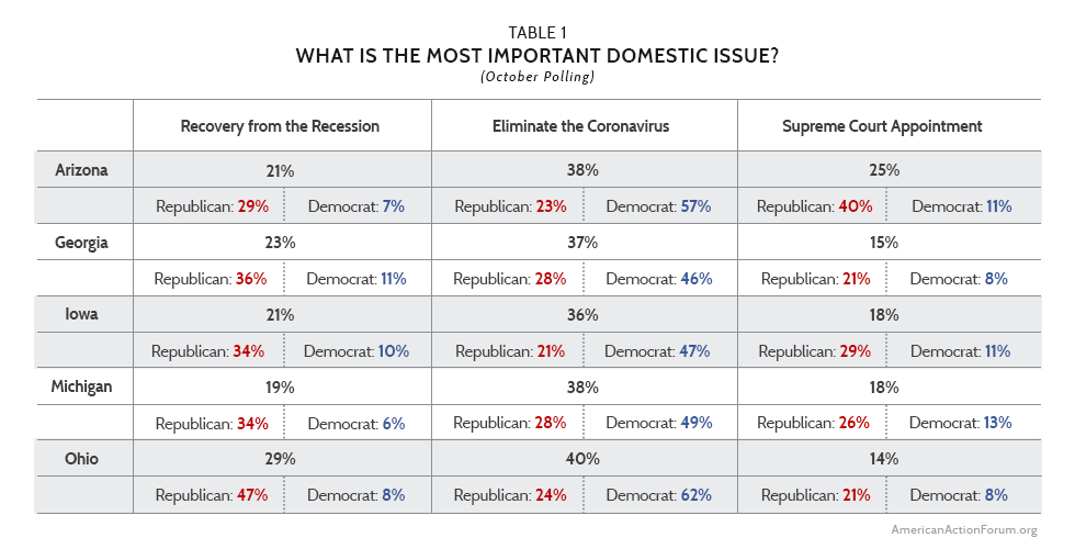Insight
October 22, 2020
Policy Priorities and the Election: New Evidence from Five States
Overview
At the beginning of October, the American Action Forum (AAF) repeated state-level polling in an effort to gauge the solid and shifting opinions of the electorate. In September AAF commissioned polling in Arizona, Georgia, Iowa, Michigan, and Ohio to identify what issues voters care about most and what policies they will support and reject. In addition to questions regarding the political context, the polls examined voters’ attitudes toward the coronavirus pandemic, additional pandemic aid spending, government spending and taxes in general, debt, labor issues, climate change, health care, tech regulation, and other policy topics.
In the main, the poll questions in October were unchanged. But in the past month there are been four important developments: (1) the candidates squared off in the first presidential campaign debate, (2) the president became infected with the coronavirus, (3) a Supreme Court vacancy was created by the passing of Justice Ruth Bader Ginsberg, and (4) national polling suggested the possibility of a sweep by Democrats of the House, Senate, and White House.
The first two questions had the potential to have a fundamental impact on the race. This matters for AAF polling because in the first round a clear finding was that the sharp partisan divide in politics spills over to nearly every policy issue as well. For example, recovering from the recession and eliminating the coronavirus were nearly tied as the most important domestic issue, but the former was a runaway leader among Republicans and the latter among Democrats. Anything that changes the partisan balance in the race will affect the policy priorities.
AAF added questions regarding the latter two issues, specifically, how important filling the Supreme Court vacancy was as a policy issue and whether voters favored or opposed eliminating the legislative filibuster. (There has been speculation that if Democrats controlled both houses of Congress, they would change Senate rules requiring a super-majority vote, i.e. 60 votes, to end debate on an issue and move to a final vote governed by a simple majority; requiring this super-majority is known as the filibuster.)
Key Findings
The key findings are quite similar to September with two exceptions.
- On the surface, “Eliminate the Coronavirus” seems to have emerged as the top issue by a large margin. In September it was roughly on par with “Recovery from the Recession.” This shift is a result, however, of the addition of “Filling Supreme Court Vacancy” to the menu of options. Republicans are split between the latter two, with the Supreme Court actually the leading issue among Arizona Republicans. Because of this schism among Republicans, the top line appears to have shifted in favor of addressing the coronavirus (see Table 1 below).
- Respondents oppose eliminating the legislative filibuster by large margins and nearly on a bipartisan basis. In Ohio, however, Democrats favor eliminating the filibuster 45 percent to 37 percent.
Methods and Data
The polls were conducted in the first and second weeks of October. For each of the states (Arizona, Georgia, Iowa, Michigan, and Ohio) the polling firms produced three products: an overview and summary, a tabulation of the responses to each question, and a set of cross-tabulations that permit one to examine patterns in the responses. These documents contain sample sizes, polling dates, and other documentation; they can be found here:











